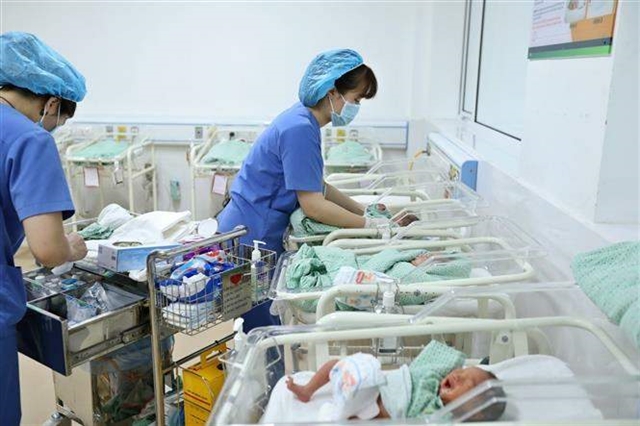 Society
Society


|
| Newborn babies in HCM City. —VNA/VNS Photo |
HÀ NỘI — Việt Nam has successfully controlled the rapid population growth, maintained a reasonable population size, and kept the total replacement fertility rate for nearly 15 years, as results of population work over the past six decades show.
Notably, the average life expectancy of Vietnamese people increased by 33.7 years, from 40 in 1960 to 73.7 in 2020. The rates of malnutrition and child mortality have decreased by two thirds; while the maternal mortality rate dropped by three quarters.
The success in the population and family planning tasks over the past 60 years has helped Việt Nam achieve and complete ahead of the schedule Millennium Development Goals (MDGs) about improving maternal health (MDG5) and reducing mortality rate among children (MDG4).
In 1999, Việt Nam received the United Nations Population Award.
The country entered the golden age of population structure in 2007, which peaked in 2020, with the working age population accounting for about 70 per cent of the total population. This phase is expected to last about 30-40 years.
However, the population work is facing both opportunities and challenges.
Việt Nam is experiencing a significant disparity in birth rates among regions, affecting its rapid and sustainable development. Meanwhile, gender imbalance at birth has appeared since the early years of the 21st century and increasingly spread in both urban and rural areas, with the sex ratio being at over 110 male births for every 100 female births from 2006 to present.
Việt Nam is at the golden age of population structure and the country's socio-economy will face difficulties if it fails to tap this opportunity, particularly when the "golden" population will become the "old" population after 2035.
The average life expectancy of Vietnamese people has increased, but the number of years living healthy life is lower than many countries. Elderly people face the burden of "double diseases" and often suffer from chronic diseases. On average, each elderly person has three diseases, facing the risk of disability due to the aging process and high treatment costs and long-term treatment and care.
According to the UN’s World Population Prospects, the global human population will reach 8 billion in mid-November 2022. To celebrate World Population Day this year, the UN Population Fund (UNFPA) has chosen the theme "A world of 8 billion: Towards a resilient future for all - Harnessing opportunities and ensuring rights and choices for all".
At the time when the world population reaches 8 billion, it will pose many urgent challenges that have impacts on many generations.
Climate changes, conflicts and COVID-19 pandemic are all issues that have caused unequal impacts on vulnerable groups of population.
Globally millions of people still live in poverty, lack nutrition and do not have access to healthcare services or qualified education programmes.
As such, the UNFPA is calling for countries, including Việt Nam, to invest in human and physical capital for inclusive, productive societies that uphold human and reproductive rights. Only then can we tackle the enormous challenges facing our planet and forge a world where health, dignity and education are rights and realities, not privileges and empty promises. — VNS




